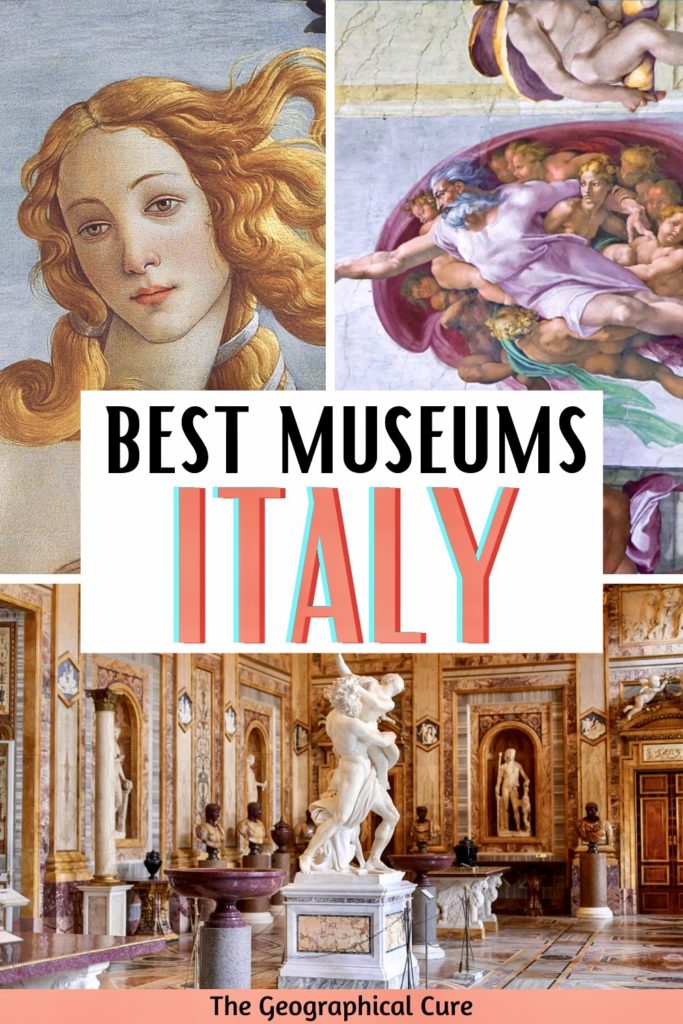Are you an art lover planning a trip to Italy? Here’s my guide to the 25 best museums in Italy.
Italy is one of the most popular countries on earth — with a rich ancient Roman history and some of the world’s most iconic landmarks.
But Italy is also home to some of the world’s most revered museums and artistic masterpieces. Italian museums house famous paintings, sculpture, and frescos from ancient Rome to the Renaissance.
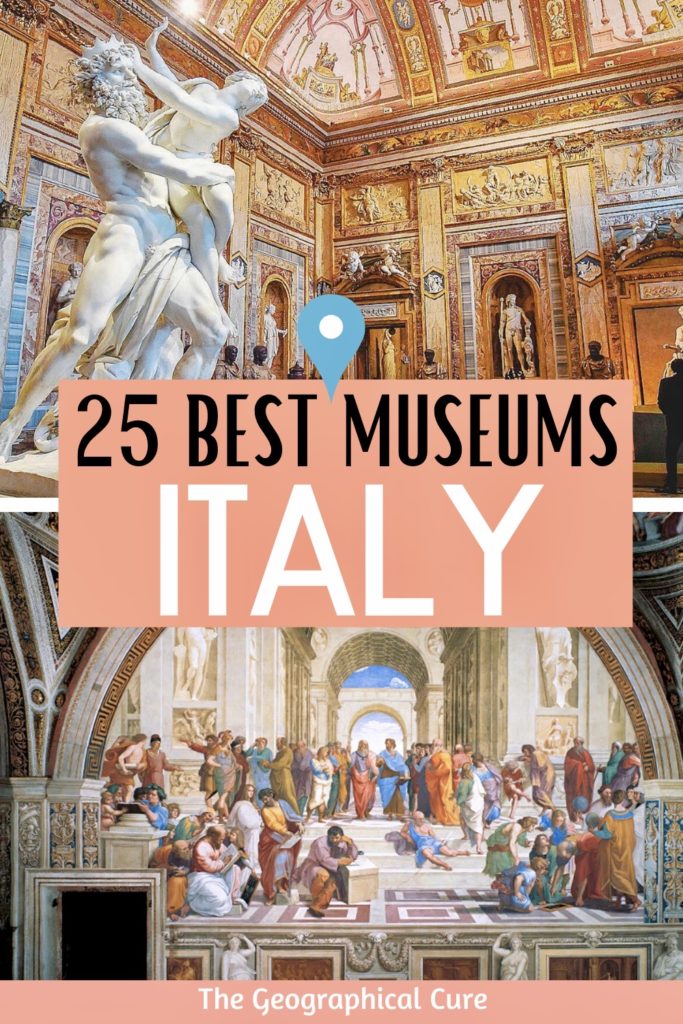
Some of Italy’s best museums are in hotspots like Rome, Florence, and Venice.
Others are tucked away in secret spots, off the beaten path towns in Italy, or hidden behind the ornate doors of Italy’s churches.
Let’s peak behind the elegant facades and tour the best museums in Italy. We’ll visit frescoed churches and elegant palaces. The architecture is almost as magnificent as the art.
Guide To The Best Museums In Italy
Here are my picks for the 25+ best museums in Italy. I’ve also tried to provide links so that you can virtually tour the museums.
1. The Vatican Museums, Vatican City
The Vatican Museums are the public art and sculpture museums in the Vatican City complex. They are the best and most famous museums in Italy.
The works in the Vatican are invaluable crowning glories of Western art. They tell stories of the rise and fall of the Roman Empire, the history of the Catholic Church, and the birth of the Renaissance.
The museums house over 70,000 densely packed works of art (not all on display).
There’s a museum path that takes you through the long corridors and wings of the Vatican Museums.
On the first floor, you’ll find the Vatican Pinacoteca, the Pio-Clementine Museum, the Chiaramonte Museum, the Gregorian Egyptian Museum, and the Gregorian Etruscan Museum.
On the second floor, you’ll find the Tapestries Hall, the Gallery of Maps, and the Raphael Rooms. The Raphael Rooms are four rooms, which were the public rooms of the pope’s personal apartments in the time of Julius II.
They were painted by the famous Raphael. The most famous fresco is The School of Athens.
Your last stop will be the stunning Sistine Chapel, with the world famous Michelangelo frescos.
You can take an online virtual tour of the Vatican Museums, including the Sistine Chapel, the Pio Clementino Museum, and the Raphael Rooms. You can also tour Vatican City on Google Arts & Culture.
Here are all my articles about visiting the Vatican:
- Masterpieces of the Vatican
- Guide to the Vatican Pinacoteca
- Guide to the Vatican’s Raphael Rooms
- Guide to the Sistine Chapel
- Underpants in the Sistine Chapel
- Guide to St. Peter’s Basilica
- 1 day itinerary for Vatican City
- Hidden gems in the Vatican
- Famous sculptures in the Vatican
Since this is Italy’s most famous museum, you absolutely must pre-book a skip the line tickets. Or else you’ll be stuck in line for hours unless it’s the dead of winter. You may also want to book a guided tour.
2. Uffizi Gallery, Florence
The Uffizi Gallery has one of the world’s best collections of Renaissance art, collected by the powerful Medici family. After the Vatican Museums, it’s the most famous museum in Italy.
The museum is vast, with 93 halls spread over two floors. It’s said that if you spent just one minute in front of the Uffizi masterpieces, you’d be there for 33 days.
The Uffizi houses priceless treasures. Along its marble corridors, you can admire Sandro Botticelli’s The Birth of Venus, Laocoön and his Sons, Piero della Francesca’s unflattering portraits of the Duke and Duchess of Urbino, and Raphael’s Portrait of Pope Leo X with Two Cardinals.
In 2018, the Uffizi unveiled a permanent home, Room 35, for its two da Vinci heavyweights — Adoration of the Magi and Annunciation.
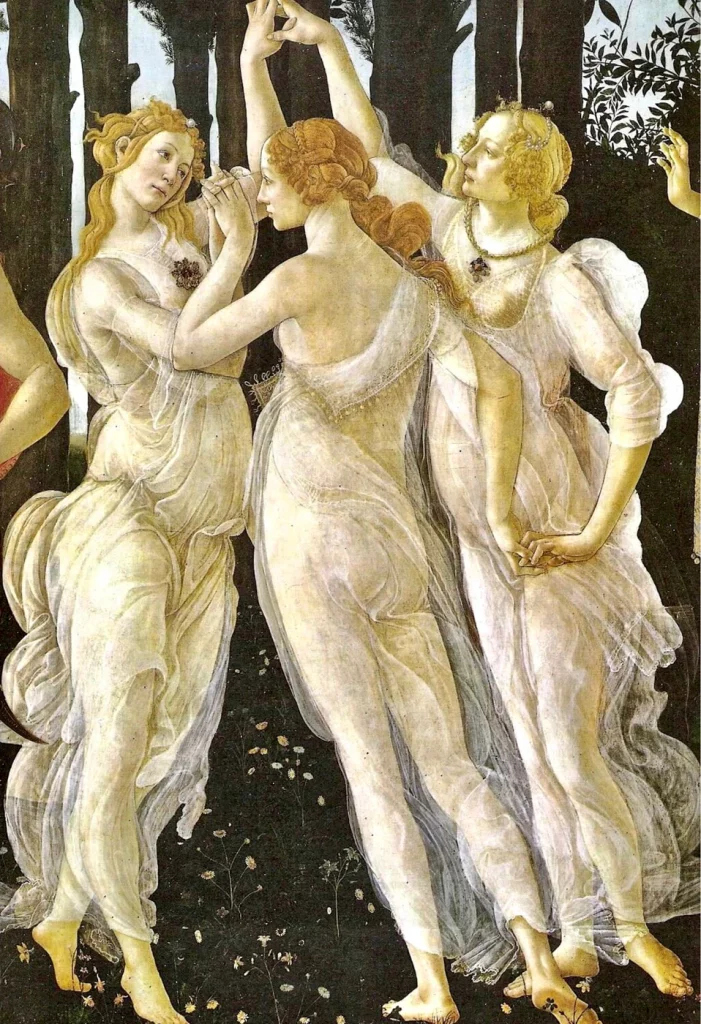
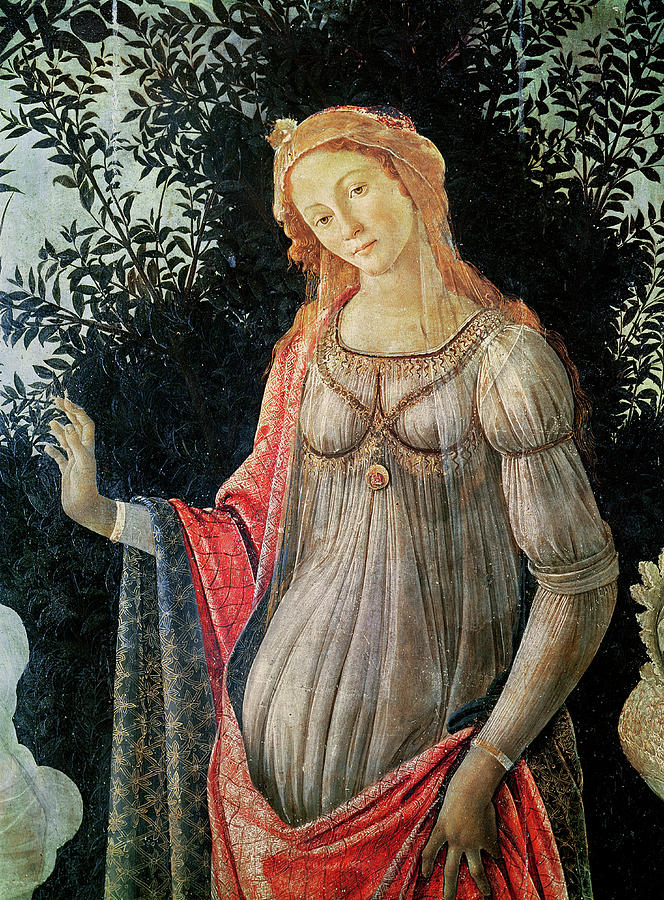
Art lovers can take a virtual tour on the Uffizi Gallery Facebook page. Or, install the Google Arts & Culture App to explore the entire collection.
The Uffizi’s own HyperVision tours are also excellent, analyzing masterpieces or focusing on a particular theme. If you want to take a deep dive into the catalog, the Uffizi also has a digital archive.
READ: Botticelli Trail in Florence
If you need more Uffizi, here’s for my complete guide to visiting the Uffizi and here’s my guide with ticket tips and tips on how to prepare for a visit to the Uffizi.
Click here to book a timed entry skip the line ticket. I recently visited on this a 2 hour private tour and it was fabulous.
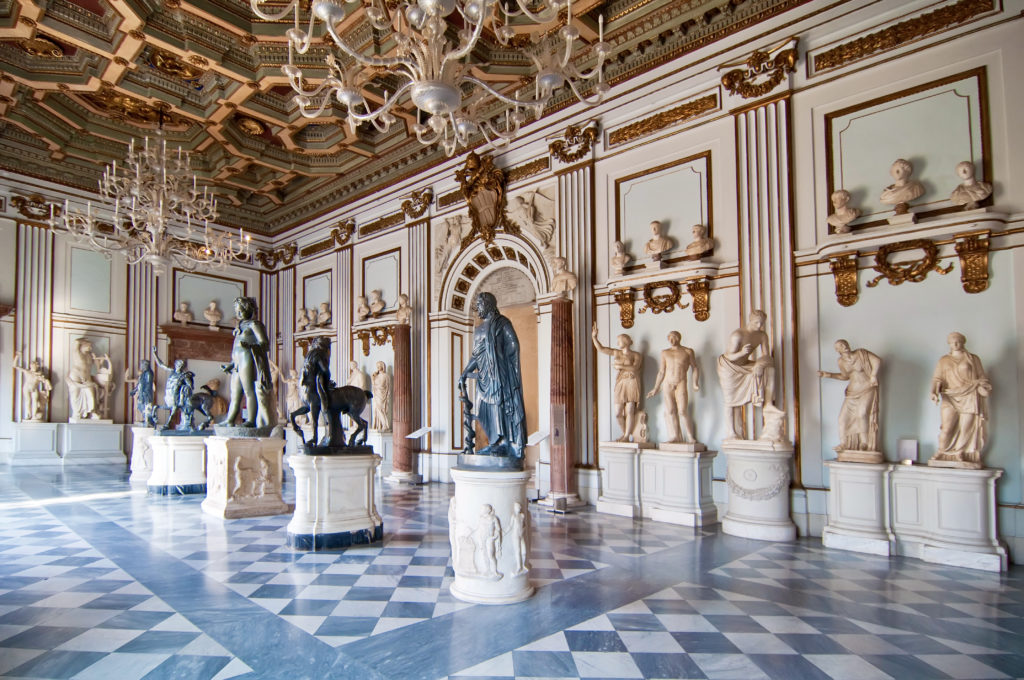
3. The Capitoline Museums, Rome
The Capitoline Museums are Rome’s oldest museum complex, sitting atop a beautiful square, the Piazza dei Campidoglio on Capitoline Hill.
The museums give you a unique look at Rome’s ancient imperial history. If you’re a history or archaeology buff, this is a must see site in Rome.
The Capitoline’s stash of ancient art and artifacts is unparalleled. It’s housed in two buildings, the Palazzo dei Conservatori and the Palazzo Nuovo. They’re connected by an underground passageway, called the Underground Galleria Lapidaria, lined with evocative funereal steles.
The Capitoline Museums boast an enormous array of ancient Roman, medieval, and Renaissance art — statuary, paintings, and relics. The most famous pieces are the Equestrian Statue of Marcus Aurelius, Dying Gaul, Medusa, Capitoline Venus, Spinario, and Bust of Commodus.
If you want to take a gander at ancient Greco-Roman sculpture, the Capitoline Museums have a virtual tour of the museum’s floor plans and collections. I’ve also written a full guide to the Capitoline Museums.
>>> Click here to book a skip the line ticket
4. Ara Pacis Museum, Rome
The Roman Senate commissioned the Ara Pacis, or Altar of Peace, in 13 BC. The altar was built to honor soon-to-be emperor Augustus, who had just pacified and defeated the barbarians.
His victory marked the beginning of the Pax Romana, a 200 year golden age where arts and architecture flourished.
The altar was once part of a large complex. It was moved to its current location in 1938. The Ara Pacis Museum opened in 2006 and is dedicated to this single monument.
The museum is housed in a modern pavilion designed by American architect Richard Meier. You can skip the rather outrageous entry fee and admire the ornate altar on the museum’s virtual tour here. Or visit the museum virtually on Google Arts & Culture.
>>> Click here to book a ticket
5. Trajan’s Market, Rome
Trajan’s Market is a large complex of ruins that was part of Trajan’s Forum. This forum was the largest and most advanced of the six imperial forums in Rome, as befitting Rome’s most popular and powerful emperor dubbed the “best leader.”
READ: Best Ruins and Archaeological Sites in Rome
Trajan’s Market was built in the 2nd century AD by Trajan’s favorite architect, Apollodorus of Damascus. It’s affectionately called the world’s “first shopping mall.”
Trajan’s Market was a dense complex. It was once 6 stories high with 150 shops and offices, set into the side of Quirinal Hill.
The structure is remarkable. It shows that Romans didn’t just build with columns and pediments. Powered by concrete, this urban structure was light filled, with windows and atriums.
Now, you can take an amazing virtual tour of Trajan’s Market from your couch.
>>> Click here to book a skip the line ticket
6. Pinacoteca di Brera, Milan
The Pinacoteca di Brera is housed inside the beautiful late 17th century Palazzo Brera near the Duomo in Milan. The museum has a magnificent collection of Italian art, especially religious-themed works. It’s one of the best museums in Italy that you’ve never heard of.
READ: 1 Day Itinerary for Milan
The Pinacoteca di Brera boasts works from the 14th to 20th centuries, including pieces by artists such as Raphael, Caravaggio, Guercino, Bellini, and Titian.
The museum’s must see masterpieces are Caravaggio’s Supper at Emmaus, Francesco Hayez’s The Kiss, Andrea Mantegna’s Lamentation of Christ, and Guercino’s Dead Christ.
The gallery has created an online catalog of over 600 art works. You can admire the art online and read relevant historical details in Italian or English. The collection can be searched by date and artist. Visit it here.
You can also check out my complete guide to the Brera Museum.
>>> Click here to book a guided tour of the museum
7. The Pantheon, Rome
Without a doubt, the Pantheon is the best preserved building from ancient Rome. You’d don’t have to wrinkle your brow or struggle to conceptualize anything, as with many ruins. It’s all before you.
Built in 120 AD by Emperor Hadrian, the Pantheon was a temple dedicated to all of the gods. Hadrian reimagined it as an oversized Greek temple — with 40 foot tall Corinthian granite columns from Egypt, a pediment, and portico. It was considered a masterpiece of engineering and mathematical precision.
READ: Guide To Hadrian’s Villa
The Pantheon’s most emblematic feature is its perfect unsupported spherical dome. At the time, it was a major architectural breakthrough.
The dome became the model for Michelangelo’s dome for St. Peter’s Basilica and Brunelleschi’s dome for Florence Cathedral.
You can take a 360 tour of the Pantheon here. And here’s a fantastic video from Smarthistory with shots of the Pantheon and an explanation of its importance.
The Pantheon used to be free to visit. But as of July 2023, it started charging admission. To avoid long lines, I advise booking a fast track skip the line ticket.
8. The Ruins of Pompeii, Pompeii
Pompeii is Rome’s most famous archaeological site, a living museum in Italy. In 79 AD, Mount Vesuvius erupted and buried the city in 60 feet of ash.
The city was entombed for many centuries. Beginning in 1748, archaeologists began painstakingly excavating the ruins.
The ruins are a remarkable evocation of everyday Roman life. You can get a vicarious thrill sharing living space with ancient Romans.
In the complex, you’ll find roman baths, a roman forum, brothels, basilicas, a grand theater, and the oldest Roman amphitheater in the world. The most important monuments are the Temple of Apollo, the city bathhouse, and the villas of the nobility.
The Villa of the Mysteries is probably the most important home. It contains one of the most famous frescos from all of Ancient Rome, The Mysteries of Dionyus, which covers three walls. It’s been recently renovated, so positively glows.
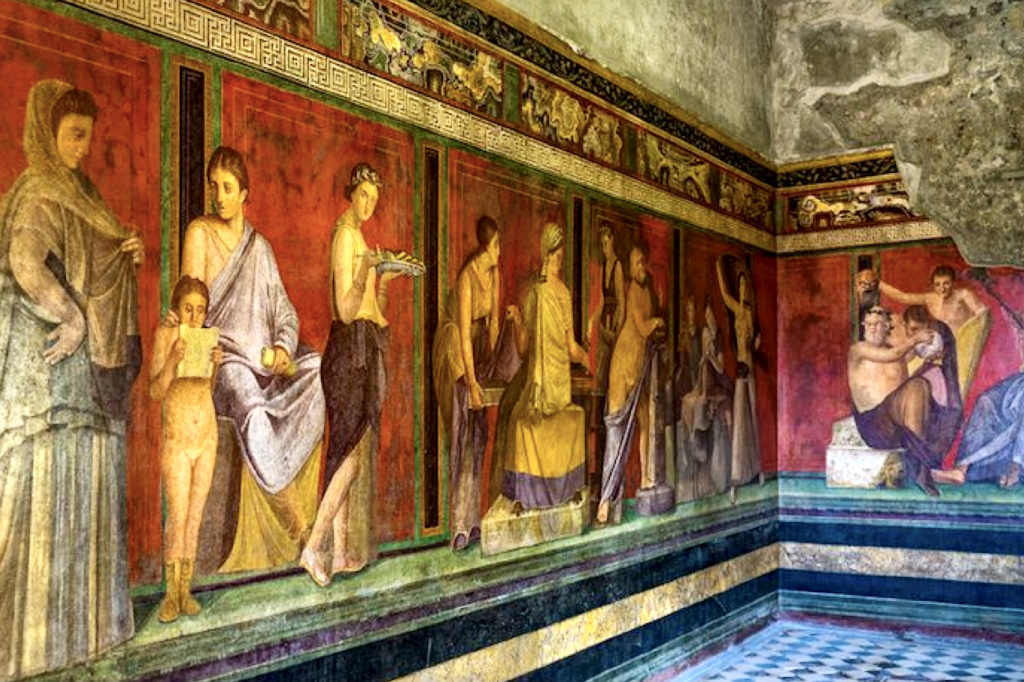
The House of the Vettii is also newly opened, with some gorgeous frescos. New finds are made all the time.
Today, Google allows you to step back into this ancient world locked in time. Using Google Street view, you can tour Pompeii in 3D from the comfort of your own home.
To begin a tour of the ancient Roman city, click here. Drag your mouse or tilt your phone to get a good look around.
Unless you’re visiting in the winter, I would be sure to book a skip the line ticket in advance. You can also book a guided tour with an archaeologist.
For more information and practical tips, here’s my complete guide to visiting Pompeii.
9. Museo e Real Bosco di Capodimonte, Naples
Located in the Capodimonte Palace, the underrated Capodimonte Museum houses a collection of fine and decorative arts mostly from Naples. The core of its collection was compiled by the powerful Farnese and Bourbon families.
The Capodimonte Museum features stunning range of works by Caravaggio, Masaccio, Titian, Raphael, El Greco, Bruegel, and Sebastiano del Piombo (who also decorated the Villa Farnesina in Rome).
The museum’s most famous painting is Caravaggio’s The Flagellation of Christ. It hangs solo in its own room on the second floor. You can visit the museum’s online collection here.
The artistic gems of the Capodimonte Museum can also be admired via Google Art & Culture. The platform gathers over 500 works of art, themed stories, and virtual tours of the museum masterpieces.
Here’s my complete guide to the Museo di Capodimonte. In high season, you should book a skip the line ticket.
10. Museo Nazionale di Castel Sant’Angelo, Rome
Built on the banks of the Tiber River in 139 by Emperor Hadrian, Castle Sant’ Angelo is also known as Hadrian’s Mausoleum.
Hadrian also erected the Bridge of Angels, which connected his grand mausoleum to central Rome. The bridge is now lined with 10 angels, designed by Baroque master Gian Lorenzo Bernini. Each statue holds an object of Christ’s passion.
The cylindrical castle was richly decorated. Originally, it was faced with travertine marble, pilasters, and bronze. By the 5th century, the mausoleum was converted into a miltary fortress.
It was renamed Castle Sant’Angelo in the 5th century. Legend holds that the Archangel Michael appeared above the castle, sheathed his sword, and magically put an end to the plague.
In the 15th century, the notorious Borgia pope, Alessandro VI, installed sumptuous papal apartments. They’re decorated with frescos by Pinturicchio, who also decorated the Borgia Rooms in the Vatican Museums.
You can take a virtual 360 tour of the castle here. Here’s my complete guide to Castle Sant’Angelo.
>>> Click here to book skip the line ticket
11. Peggy Guggenheim Collection, Venice
The Peggy Guggenheim Collection is a must see site in Venice for art lovers. It’s the city’s best museum and the single greatest museum of 20th century art in Italy.
Upon visiting, as Guggenheim intended, you’re greeted at the door by an erect penis. It’s a sculpture by Marino Marini — a man astride his horse, excited by the pure joy of living in Venice.
READ: 2 day Itinerary for Venice
Housed in Guggenheim’s former palazzo, the Peggy Guggenheim Collection was opened in 1980 and is now a shrine.
The quality of the paintings is staggering, a tribute to Guggenheim’s acquisition strategy during the golden age of modern art.
Guggenheim’s collection includes works from the major movements of Cubism, Surrealism, Futurism, and Abstract Expressionism. There’s an entire room dedicated to her beloved Jackson Pollack.
You can see works by Picasso, de Chirico, Kandinsky, Miro, Klee, Ernst, Magritte, de Kooning, Dali, and Calder.
Highlights of the collection can be viewed online here. Here’s my complete guide to Peggy Guggenheim Museum in Venice.
>>> Click here to book a must have skip the line ticket
12. Galleria dell’Accademia, Florence
After the Uffizi, Florence’s other star gallery is the Accademia. The Accademia is one of the Italy’s best and most famous museums.
The Accademia is home to some of Michelangelo’s most famous works — David and the Slaves.
David is arguably the world’s most famous sculpture. It’s a beautiful piece of art displayed in a beautiful setting.
The Slaves were originally intended for the Tomb of Pope Julius II. But Michelangelo was never able to finish the project. In contrast to David, the Slaves struggle to emerge from the marble
Although the Accademia doesn’t offer as much virtually as the Uffizi, its site still contains information, beautiful photos of its most important pieces, and some story videos.
If you want to see Michelangelo’s David, click here for my complete guide to Florence’s Galleria dell’Accademia with ticket tips.
You should definitely book a skip the line ticket. After the Uffizi, this is the most popular museum in Florence. You may also want to book a guided tour of the museum.
13. Museo Napoleonico, Rome
Housed in the Palazzo Primoli, this Roman museum is dedicated to the period of Napoleon and his connection to Italy.
Located just north of the Piazza Navona, the museum contains the collections of Count Giuseppe Primoli. He was the great grandson of Joseph and Lucien Bonaparte.
Primoli’s aim was to present the imperial family from his own private point of view. The museum is still arranged as he envisioned it.
You’ll find painting, artifacts, sculptures, Napoleon’s outfits, books, memorabilia, etc. If you’re a history buff, this museum is for you.
The Museo Napoleonico has an excellent multimedia virtual tour. You can take a 360 tour of the collection. Or you can go to the photo gallery, click on a specific photo, and get a wealth of information.
14. Villa Farnesina, Rome
Another beautiful place to admire the works of Raphael is at the Villa Farnesina. Designed by artist-architect Baldasarre Perruzi, the 16th century Villa Farnesina is a magnificent off the beaten path museum, located in Rome’s lovely Trastevere neighborhood.
Villa Farnesina is a quiet oasis of in situ art and architecture.It’s home to torrid love stories and secret Raphael paintings.
The villa is decorated with racy mythological frescos by Renaissance painters Raphael, Peruzzi, and Sebastian del Piombo. If you’re a Renaissance art lover, Villa Farnesina should be on your itinerary for Rome.
You can now take a virtual 360 tour of Villa Farnesina. Check out the Loggia of Cupid and Psyche, the Hall of Galatea, and the Room of the Perspectives.
I loved the little museum so much that I wrote a complete guide to the Villa Farnesina. You can book a 2 hour private tour of the Villa Farnesina or a guided tour of Villa Farnesina and walk through Trastevere.
15. The Quirinal Palace, Rome
The Quirinal Palace, or Palazzo del Quirinale, was built by Gregory XIII in 1574 as a summer residence. Now it’s the official home of the Italian President.
You can take a 360 guided tour of the palace with audio commentary.
Along the way, you’ll see the Hall of the Mirrors, the Great Ballroom, the First State Room, the private chapel, and the spectacular Mascarino Staircase. You can even take a tour of the gardens.
16. The Doge’s Palace, Venice
No list of the best museums in Italy would be complete with mentioning the Doge’s Palace in Venice.
Set in St. Mark’s Square, the Doge’s Palace or Palazzo Ducale is the very symbol of Venice. This pink and white marble Gothic-Renaissance building was the official residence of the doges who ruled Venice for more than 1,000 years.
You enter the palace via a grand courtyard. Head inside and ascend the Golden Staircase, Scala d’Oro.
It’s one of the world’s most richly decorated staircases. From the staircase, you’ll have two views: one of the majestic courtyard of the Doge’s Palace and another of the Bridge of Sighs.
Inside the grand interior are some true masterpieces of Renaissance and Venetian art. Be sure to see Veronese’s Rape of Europa and The Triumph of Venice, paintings and ceilings by Tintoretto and Veronese, and Tiepolo’s Neptune Bestowing Gifts upon Venice.
The Doge’s Palace also has the world’s largest oil painting Tintoretto’s Il Paradiso. It dominates the Great Council, which is the the main hall of the palace.
If you buy tickets for the special Secret Itineraries Tour, you’ll go beyond the public rooms and pass into the private chambers, judges’ chambers, interrogation rooms, and prisons.
For more information, here’s my complete guide to the Doge’s Palace.
>>> Click here to book a ticket to the Doge’s Palace
17. Doria Pamphilj, Rome
The Galleria Doria Pamphilj is one of the best museums in Italy and one of my absolute favorite spots in Rome. It’s a hidden gem housed in a lavish 17th century Roman-Rococo palace.
The art collection was meticulously assembled and is still owned by a powerful Italian family, the Doria Pamphilj (pronounced Pom-fee-lee).
The museum boasts over 650 works spanning the 15th to the 18th century, including pieces by Bernini, Caravaggio, Velazquez, Titian, Carracci, and Bruegel. Apart from the art, every inch of the walls and ceilings are decorated with beautiful frescos, tapestries, and chandeliers.
You can virtually tour the Doria Pamphilj here. You can also check out my complete guide to visiting the Doria Pamphilj in Rome.
>>> Click here to book a skip the line ticket
18. National Museum of the Bargello, Florence
The Bargello dates from 1255. In 1865, the Bargello opened as a museum by royal decree. It’s now one of Italy’s best museums.
The Bargello houses an amazing collection of Renaissance sculptures. The most important works are in the Michelangelo and Donatello rooms. Those include Michelangelo’s first major sculpture, Bacchus, and his Pitti Tondo, Donatello’s acclaimed Bronze David and St. George, and Bernini’s Bust of Costanza.
READ: Bernini Guide To Rome
The Bargello also houses the Competition Panels. In 1401, Florence held a competition for a set of bronze doors to be made for the Baptistry of the Duomo. Artists submitted bronze samples.
Ghiberti and Brunelleschi were the finalists, with Ghiberti winning the competition. Here’s my guide to the Bargello and its must see masterpieces.
>>> Click here to book a skip the line ticket
19. Leonardo’s The Last Supper | Santa Marie delle Grazie
The Last Supper is one of the world’s most iconic paintings. It’s housed in the refectory of Santa Maria delle Grazie in Milan.
Painted by Leonardo da Vinci, the billboard size painting is a Renaissance masterpiece. Not only is The Last Supper famous, it’s a fascinating and spellbinding artwork surrounded by mysteries and legends.
The Last Supper depicts the last meal Jesus took with his apostles. The long table is crowded. Each figure is unique and memorable, all facing the viewer. Judas holds a bag of silver that was his bribe money.
Christ is in the center, with a window frame serving as his halo. The fresco shows the climactic moment after Christ announces his imminent death, saying “One of you will betray me.”
Here’s my guide to visiting The Last Supper and how to see it. You can tour it virtually via this Smarthistory video.
You have to plan in advance to see this wonder. It’s sold out well in advance. Click here to book an entrance ticket. If they are sold out, you can try booking a guided tour.
20. The Opera del Duomo Museum, Florence
The Museo dell’ Opera del Duomo is the best cathedral museum in all of Italy. The museum is housed in the Piazza del Duomo at the back of Giotto’s Bell Tower, behind the Duomo apse.
It’s the same space where Michelangelo famously carved David in secret.
The Duomo Museum is a fabulous treasure box of sculpture. It boasts an unparalleled collection of Medieval and early Renaissance Florentine art.
The first thing you see is the museum’s well-lit showstopper — the Hall of Paradise. It’s also called the Hall of the First Facade. It’s the heart of the museum.
There are sculptures by artists such as Donatello, Michelangelo, Arnolfo di Cambio, and Nanni di Banco. You can see models of Brunelleschi’s famous dome and learn how it was built.
On top of the art, its rooftop terrace offers a mesmerizing view of Brunelleschi’s dome.
Here’s the official Duomo Museum website, where you can check out all the art works on display. Here’s my complete guide to visiting Florence’s Duomo Museum.
You can visit the Duomo Museum with a ticket to the cathedral complex.
21. Palazzo Barberini, Rome
Palazzo Barberini is an underrated museum in Rome. But it’s definitely an art lover’s art gallery.
Recent restorations give it an unapologetically grand wow factor. The museum holds some of Europe’s classic paintings by the great masters.
The Barberini Palace is 12,000 square meters and has 187 rooms. It has beautiful staircases by Borromini and Bernini. It’s home to one of Raphael’s most famous paintings, La Fornarina.
It’s a painting of the “baker’s daughter,” whom Raphael had fallen in love with while fresco painting in the Villa Farnesina.
Other master works include Caravaggio’s Narcissus and Judith and Holofernes, Holbein’s Henry VIII, and the ceiling fresco by Pietro da Cortona.
You can take a live tour with a museum guide here and a virtual tour with a museum curator on YouTube here.
READ: Secret Palace Museums in Rome
>>> Click here to book a skip the line ticket
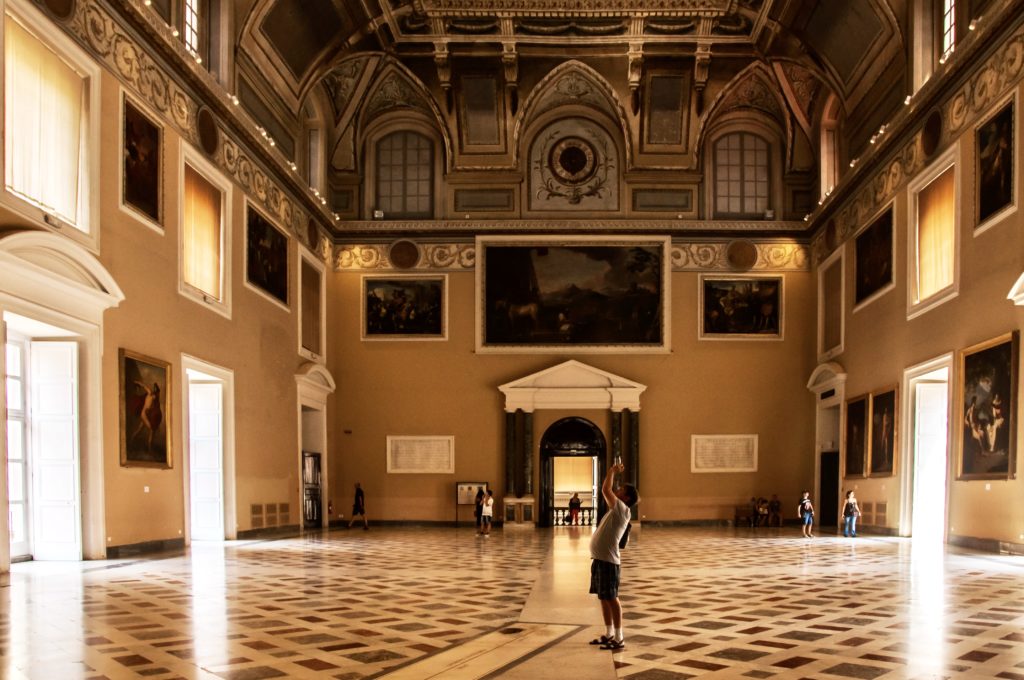
22. Archaeological Museum, Naples
The Museo Archeologico Nazionale is one of the world’s best archaeological museums.
You can see original mosaics and frescoes from Pompeii and Herculaneum. The original of the much reproduced Attenti al Cane (“Beware of the Dog”) mosaic is here, as are the Villa of Papyri frescoes.
The most famous mosaic depicts the battle between Alexander the Great and Darius III of Persia. It’s considered one of the most important and impressive mosaics from the ancient world. Right now, it’s being restored.
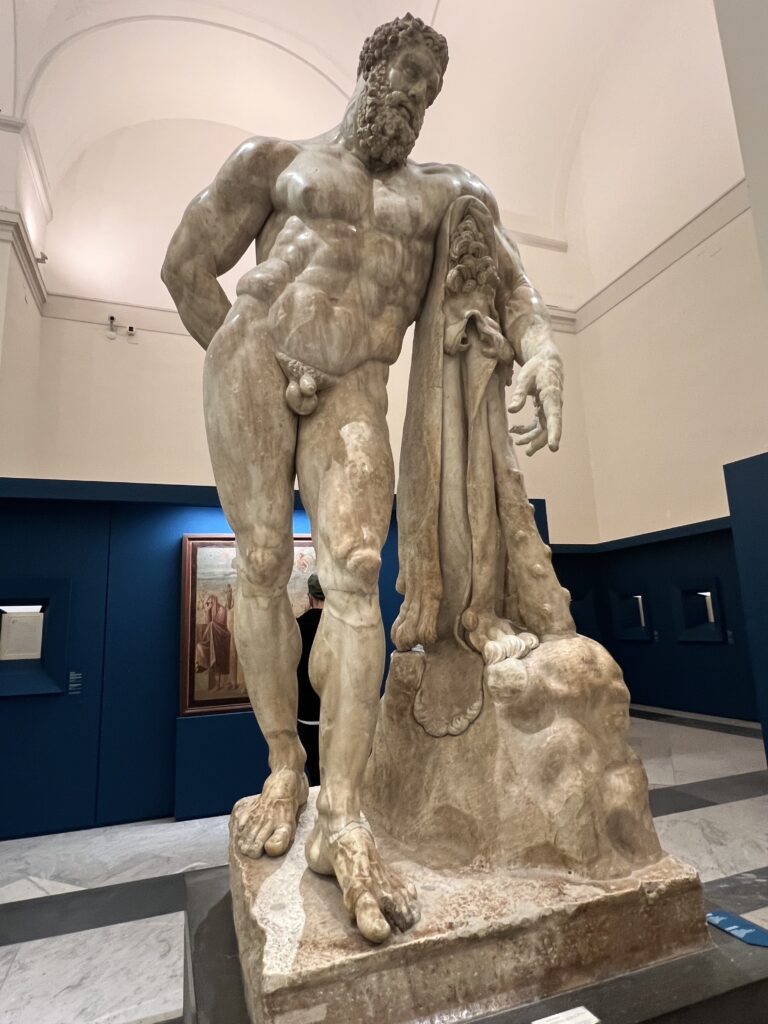
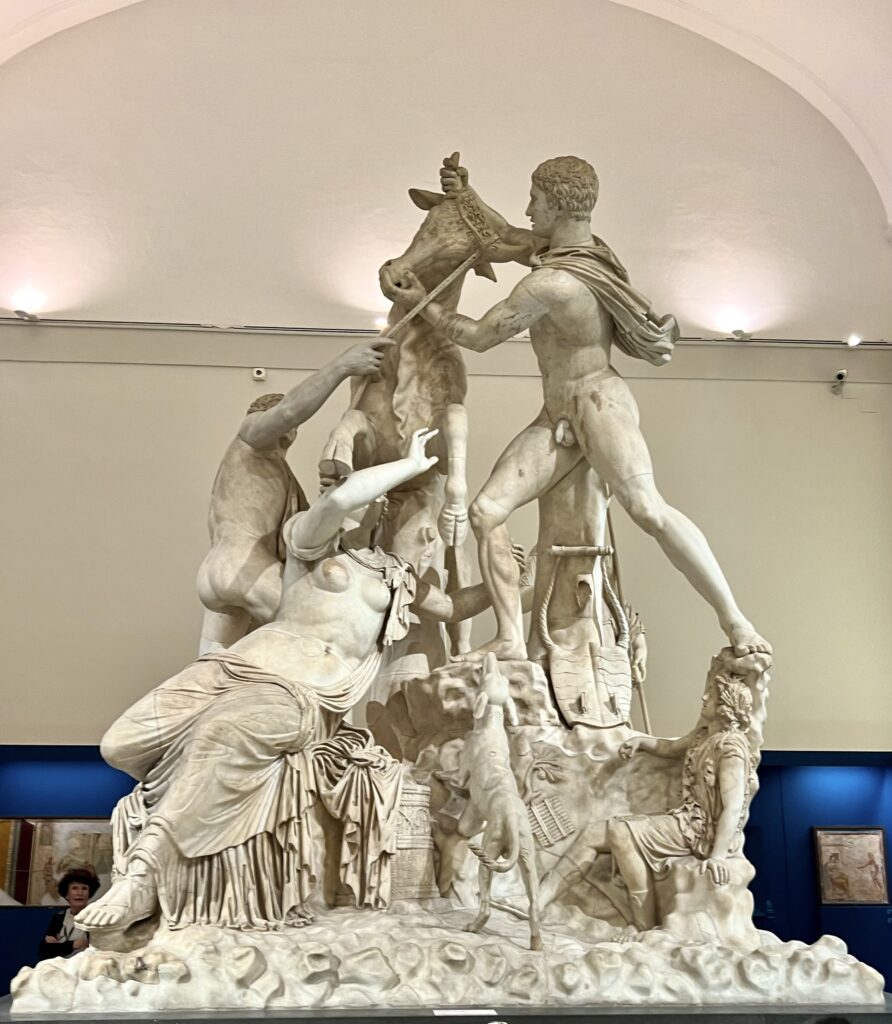
Much else waits you, including a racy Secret Cabinet collection and some of the finest statuary to survive from ancient Europe in the Farnese Collection.
The most famous piece is the massive Farnese Bull, which once decorated Rome’s Baths of Caracalla. Another stunner is the Farnese Hercules, in which a super buff Hercules leans on his club after completing his 11th labor.
You can take a virtual tour of the museum on Google Arts & Culture. And for more details and tips, check out my guide to visiting the Naples National Archaeological Museum.
>>> Click here to book a skip the line ticket
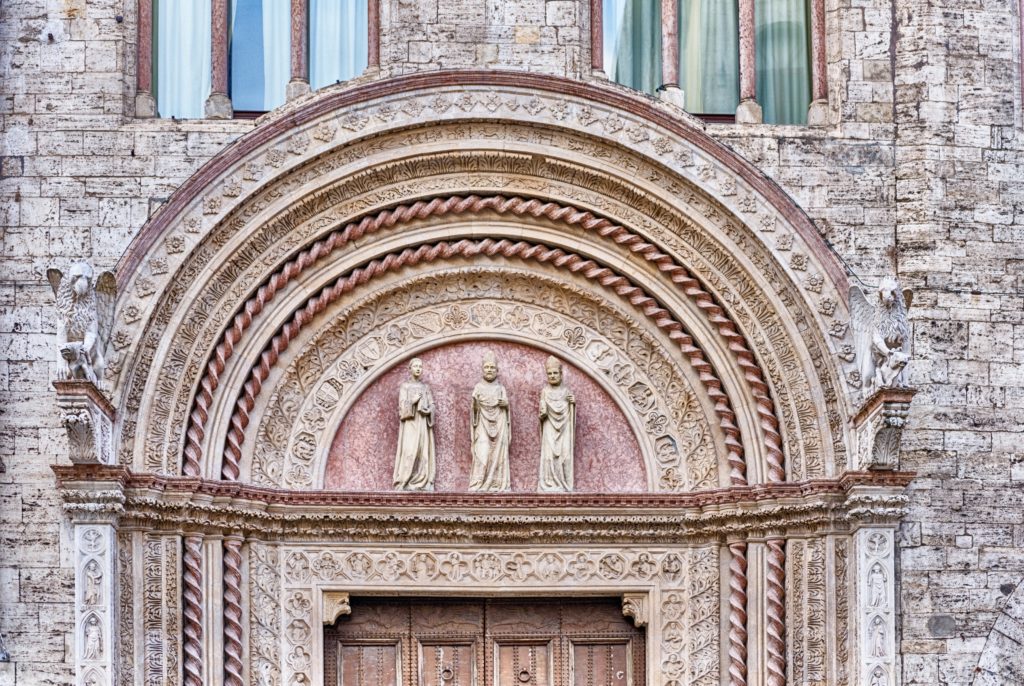
23. Umbria National Gallery, Perugia
The National Gallery of Umbria is a vastly underrated museum. It’s housed on the top floor of the magnificent Palazzo dei Priori in Perugia in Umbria.
You’ll get a huge dose of Italian culture and art. The palace itself is an architectural masterpiece, worth the ticket price.
It houses a world class collection of paintings, most executed in Tuscany or Umbria, from the 13th and the 19th centuries.
You’ll find works by an all star cast of painters, including Fra Angelico, Piero della Francesco, Perugino, Duccio, and Gozzoli.
From the Sala Podiani, you have an excellent view of Perugia’s main square, the Piazza Novembre IV.
You can check out the art works on the museum website or check out this YouTube video.
24. Basilica of San Francesco, Arezzo
Arezzo’s Basilica of San Francesco houses Piero della Francesca’s famous Legend of the True Cross fresco cycle.
It’s hugely important, considered one of the great and most influential frescos of the early 15th century.
Piero used a then still innovative single point perspective. He populated the frescos with serene figures with his trademark perfectly oval heads.
Piero was a subtle artist who used a harmonious combination of color, light, and exactitude of line. His work is elegant and extremely refined.
The fresco tells the story of the cross on which Christ was crucified. Amidst many narrative twists, the cross is lost, rediscovered, buried, stolen, and recovered in battle. The idea is that the cross remained the same throughout history.
You see scenes from the death of Adam, the meeting of Soloman and Sheba, and Constantine’s Dream.
There are two great battle scenes. Knights ride exquisite dancing horses amid a forest of lances.
25. San Brizio Chapel, Orvieto
Orvieto Cathedral is one of the Italy’s most beautiful churches. For 5 euros, you can step inside its San Brizio Chapel and see one of the most famous Renaissance fresco cycles on the planet.
The frescos were painted by Luca Signorelli and are in the spectacular San Brizio Chapel, which was renovated in 1996. Art lovers may want to bring a small pair of binoculars to see the frescos in detail.
The frescos are considered Signorelli’s masterpiece, his greatest and most complex work.
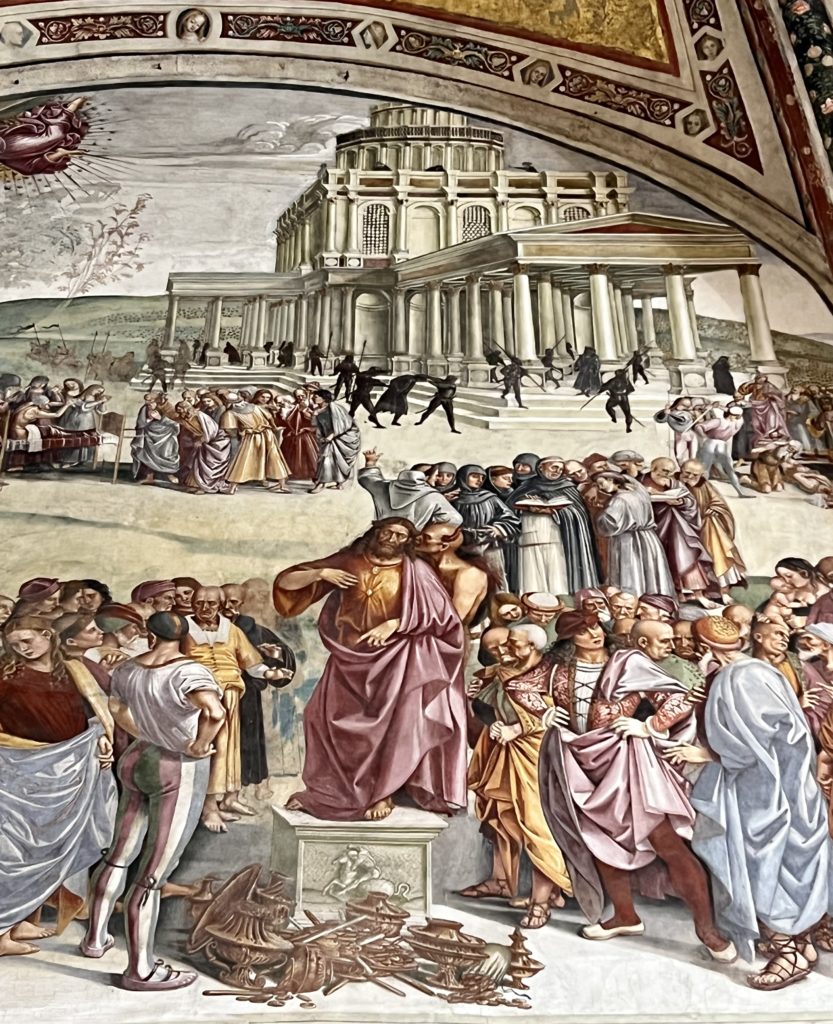
With brilliant colors and sweeping designs, they’re one of the most ambitious and inventive depictions of the apocalypse and last judgment in Italian Renaissance art.
The expressive frescos depict the usual religious themes — temptation, damnation, resurrection, and salvation. They’re a searing vision of the end of the world, executed with fiendish exuberance.
Here’s my complete guide to visiting Orvieto Cathedral. I enjoyed this 2 hour guided tour of the cathedral.
26. Brancacci Chapel, Florence
The Brancacci Chapel in Florence holds a stunning fresco cycle by the artist Masaccio. His frescos are a paramount work in art history.
They are the supreme example of early Renaissance painting. The frescos mark a key turning point in the history of art, when painting evolved from the International Gothic style to the Early Renaissance.
The Brancacci Chapel was the most influential decorative space of the 15th century. As one of Italy’s most beautiful chapels, it’s nicknamed the “Sistine Chapel of the early Renaissance.”
Here’s my complete guide to the Brancacci Chapel. Click here to take a virtual tour.
>>> Click here to book a ticket for the Brancacci Chapel
If you need even more Italian art and culture, here are some of my other Italy travel guides and resources:
- 35 Historic Landmarks in Italy
- 10 Days In Italy Itinerary
- 10 Days in Tuscany Itinerary
- One Week in Umbria Itinerary
- Beautiful Bucket List Towns in Italy
- 3 Day Rome Itinerary
- Hidden Gems in Rome
- 3 Day Itinerary for Florence
- Hidden Gems in Florence
- 2 Day Venice Itinerary
- 1 Day Milan Itinerary
If you’d like to visit Italy’s best museums virtually, pin it for later.

